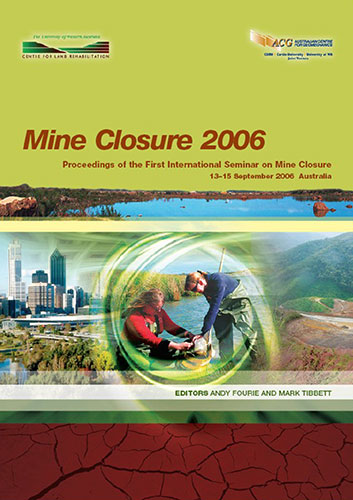Operational Environmental Systems for Mine Closure

|
Authors: Steedman, RK Paper is not available for download Contact Us |
DOI https://doi.org/10.36487/ACG_repo/605_65
Cite As:
Steedman, RK 2006, 'Operational Environmental Systems for Mine Closure', in AB Fourie & M Tibbett (eds), Mine Closure 2006: Proceedings of the First International Seminar on Mine Closure, Australian Centre for Geomechanics, Perth, pp. 741-750, https://doi.org/10.36487/ACG_repo/605_65
Abstract:
The International Council on Mining and Metals sixth sustainable development principle, is to “seek continual improvement of our environmental improvement of our environmental performance”, which includes a commitment to the design and planning of operations so that adequate resources are available to meet mine closure requirements. One measure of the mining and metals industry’s contribution to sustainable development is its long term environmental performance (Miller, 2005). It will be shown that operational observation and forecast systems are well established in earth sciences such as meteorology and if applied to mine closure, offer management an effective way to contribute to short and long term mine closure environmental obligations. Human effects, natural disasters and climate change form a significant part of the environmental risk management of mine closure. Understanding and responding to environmental risks over the short and long term present a technical and financial challenge. An operational environmental observation and forecast system that addresses the management of environmental risks of mine closure will be discussed. Effective management of environmental risks requires a rapid detection of changes over a broad spectrum in time, space and ecological complexity. The delivery of timely and appropriate information for rapid detection, prediction and management of environmental state changes is essential to have a capacity to anticipate environmental change and produce desired outcomes. The delivery of information for long term environmental performance will be examined. A system having the capacity for rapid data acquisition and analysis depends upon: remote and autonomous in situ sensing; satellite remote sensing; real time telemetry of physical biological and chemical properties; operational models assimilating data with skill and speed; and short and long term forecasting.
References:
Department of Land Information (2006) Image from NOAA NDVI Monthly Archive of Green Vegetation Cover,
IOC (2003) The strategic design plan for the coastal ocean observations module of the Global Ocean Observing System,
GOOS Publication 125, UNESCO, IOC, Paris, 190 p.
Koblinsky, C.J. and Smith, N.R. (2003) Observing oceans in the 21st Centaury, Bureau of Meteorology Publication,
Melbourne.
Malone, T.C. (2003) The coastal component of the U.S ocean observing system. Environmental Monitoring
Assessment, 81, pp. 51-62.
Malone, T.C. and Cole, M. (2000) Toward a global scale coastal ocean observing system. Oceanography, 13(1), pp. 7-
11.
Miller, C.G. (2005) Financial assurance for mine closure and reclamation. International Council on Mining and Metals,
London, pp. 25.
Operational Environmental Systems for Mine Closure R.K. Steedman
750 Mine Closure 2006, Perth, Australia
© Copyright 2025, Australian Centre for Geomechanics (ACG), The University of Western Australia. All rights reserved.
View copyright/legal information
Please direct any queries or error reports to repository-acg@uwa.edu.au
View copyright/legal information
Please direct any queries or error reports to repository-acg@uwa.edu.au